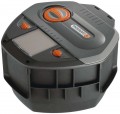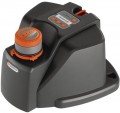Installation
The regular installation method provided for in the design of the sprinkler.
—
Platform. Stand in the form of a fairly wide base, allowing you to put the device on any more or less flat surface. At the same time, the sprinkler can stand confidently both on soft ground and on hard surfaces up to asphalt. On the other hand, the platform takes up quite a lot of space and inevitably crushes the vegetation underneath (although manufacturers try to minimize this effect, in particular, by making openings in the stand).
—
Leg. A pointed leg that, when installed, is buried in the ground. Such placement requires a minimum of space — the diameter of the legs usually does not exceed a few centimeters. It is also considered more reliable than a platform-mounted installation — the risk of the sprinkler moving accidentally is minimal. On the other hand, legs are applicable only on soft soils; in stony soil, installation may be problematic, and on a hard surface, the sprinkler will be completely useless. In addition, this method is poorly suitable for powerful heavy devices.
— Tripod. A device in the form of support legs — usually three (this number is optimal for a number of reasons), hence the name. The legs often have pointed tips for penetration into the ground, although, if necessary, the sprinkler can also be installed on a hard surface. land at only three points, occupying a minimum of
...space on the ground. In addition, the tripod makes it possible to provide height adjustment of the nozzle (see below). At the same time, such a mount significantly affects the weight and dimensions of the device, and the advantages mentioned are rarely decisive. Therefore, this installation method is typical mainly for heavy pulse and turbo sprinklers with an irrigation distance of 10 m or more.
— Hidden. An installation method that involves the deepening of the sprinkler itself into the ground — almost entirely, so that only a small part is outside. At the same time, hidden models are equipped with retractable nozzles that rise up during operation and sink back into the housing at the end of irrigation. The main advantage of such sprinklers is already clear from the name: after hours they are hidden underground. Not only does this improve the appearance of the lawn, but it also allows for trouble-free use of lawn mowers and also protects the irrigation system from animals and curious children. On the other hand, the hose to the hidden model also needs to be brought underground, which greatly complicates the installation; and the folding design affects the cost. Note that such sprinklers are quite popular in automatic programmable irrigation systems.
— Trolley on wheels. The cart used in sprinklers usually has two wheels and a third fixed support. Thus, the device can stand stably in one place thanks to the support — and by lifting it, you can easily roll the device on wheels right behind the hose connected to it. This feature is indispensable in cases where one sprinkler needs to be periodically moved from place to place. On the other hand, modern models are rarely so heavy that they are difficult to carry in the hands, and the need for movement is infrequent; therefore carts on wheels were not widely used.
— Without fastening. The complete absence of any attachment — only the sprinkler itself is supplied with a thread (or other similar device) for attaching to the attachment. Such models are convenient in two cases: if the site already has a “seat” for a sprinkler (for example, in the form of a vertical pipe, which requires only a watering nozzle) and if the owner himself wants to choose a mount, without relying on the choice of the manufacturer (for many models a variety of mounts are available and sold separately).Spraying angle (°)
The irrigation angle provided by the sprinkler during operation, in other words, the size of the horizontal circular sector in which the device operates. For angle-adjustable sprinklers (see below), this item indicates the maximum value or the range of values from minimum to maximum (more often the former, since manufacturers rarely give a specific range).
Most modern models are able to cover
a full circle — they indicate an angle of 360 °. However, pivot irrigation is not always required. In such situations, there are two options: either use a model with adjustable angle, or choose a sprinkler with a narrower irrigation angle. The advantages of the first option are described below, and the second, usually, is cheaper, and the sprinkler itself is more reliable due to its simplicity.
Hose diameter
The diameter of the hose (or pipeline) that the sprinkler is designed to connect to, in other words, the diameter of the mounting thread provided in the device. This parameter allows you to determine compatibility with a specific hose: if the mounting diameters do not match, you will not be able to connect the sprinkler directly, you will need an adapter.
Hose diameters are traditionally indicated in inches — for example, 3/4" or 1.5".

